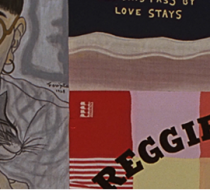AIDS Memorial Quilt Favorite
In June of 1987, a small group of strangers gathered in a San Francisco storefront to document the lives they feared history would neglect. Their goal was to create a memorial for those who had died of AIDS, and to thereby help people understand the devastating impact of the disease. This meeting of devoted friends and lovers served as the foundation of the NAMES Project AIDS Memorial Quilt.Today the Quilt is a powerful visual reminder of the AIDS pandemic. More than 47,000 individual 3-by-6-foot memorial panels — most commemorating the life of someone who has died of AIDS — have been sewn together by friends, lovers and family members. Activist BeginningsThe Quilt was conceived in November of 1985 by long-time San Francisco gay rights activist Cleve Jones. Since the 1978 assassinations of gay San Francisco Supervisor Harvey Milk and Mayor George Moscone, Jones had helped organize the annual candlelight march honoring these men. While planning the 1985 march, he learned that over 1,000 San Franciscans had been lost to AIDS. He asked each of his fellow marchers to write on placards the names of friends and loved ones who had died of AIDS. At the end of the march, Jones and others stood on ladders taping these placards to the walls of the San Francisco Federal Building. The wall of names looked like a patchwork quilt.Inspired by this sight, Jones and friends made plans for a larger memorial. A little over a year later, he created the first panel for the AIDS Memorial Quilt in memory of his friend Marvin Feldman. In June of 1987, Jones teamed up with Mike Smith and several others to formally organize the NAMES Project Foundation.Public response to the Quilt was immediate. People in the U.S. cities most affected by AIDS — Atlanta, New York, Los Angeles and San Francisco — sent panels to the San Francisco workshop. Generous donors rapidly supplied sewing machines, equipment and other materials, and many volunteered tirelessly.Throughout its 20 years history, The Quilt has been used to fight prejudice, raise awareness and funding, as a means to link hands with the global community in the fight against AIDS. Whether The Quilt is displayed as a single section in an elementary school or 1,000 of blocks on the national mall in Washington, it provides balm for the painful wounds of grief, pours oil into the waters made turbulent by controversy, opens eyes that refuse to see and enlists every person who experiences it to play a role in stopping the pandemic.







